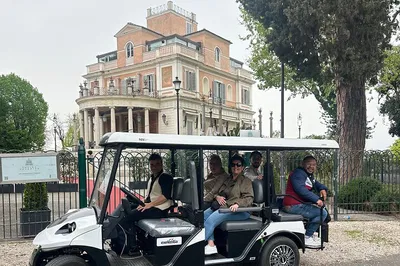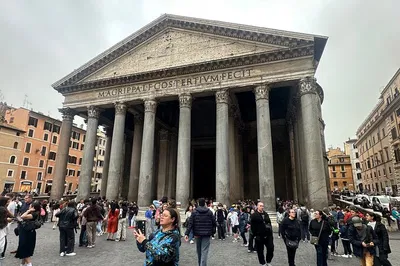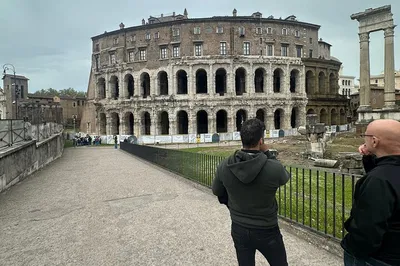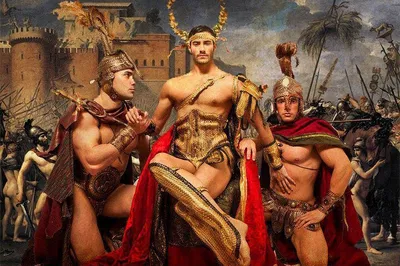Rome Golf Cart Tour: See Hidden Gems & Top Sites!
0
Overview
Rome: Golf Car City Tour with Local Guide offers a fun and unique way to see Rome's amazing sights. This tour isn't just about the big monuments; it also shows the hidden spots that have cool stories to tell. A local guide, who loves Rome, will take everyone on a trip through time, sharing interesting facts and stories that make Rome special.
See famous places like the Colosseum and the Roman Forum, where gladiators fought and leaders made big decisions. The tour will also visit the charming neighborhoods of Trastevere and the Jewish Ghetto, to get a feel for real Roman life, with its busy markets and tasty food. Guests will also get to see places of worship, where beautiful buildings and faith come together.
The tour includes fun, laughter, and a dose of culture. It excludes gratuities. Key stops include the Colosseum, Piazza Venezia, Trajan's Market, Altar of the Fatherland, Temple of Apollo Sosiano, Theatre of Marcellus, Temple of Portunus, Arch of Janus, Fontana dei Tritoni, Mouth of Truth, Temple of Hercules, and Circus Maximus.




Highlights
Zip Around Rome in Style: Explore Rome's best spots quickly and comfortably in a golf cart.
Discover Hidden Gems: See secret spots and learn cool stories that most tourists miss.
Expert Local Guide: A friendly guide will share fun facts and make Rome's history come alive.
Perfect for All Ages: A fun and easy way for families and seniors to see the city together.
Sentiment Analysis
Customers generally had a great time seeing Rome's highlights with knowledgeable guides on this fun golf cart tour. Some felt it was pricey and one mentioned the car's cleanliness.

Customers loved seeing Rome in a fun and relaxed way using the golf cart.
Many reviewers said the guides were very knowledgeable and friendly.
Several customers highlighted the tour as a great way to see many sites in a short amount of time.
Kids enjoyed this tour, and its fun for all ages and even those who have mobility issues.
Some reviewers said its a bit expensive.
One reviewer said the car could have been cleaner.
The Journey
Colosseum
Step into the Colosseum, Rome's iconic amphitheater and a testament to the grandeur of the Roman Empire. Built by emperors Vespasian and Titus, this colossal structure once hosted gladiatorial contests, public spectacles, and even mock sea battles, accommodating up to 80,000 spectators. Marvel at its elliptical design and the sophisticated engineering that allowed for a complex system of steps and corridors. Today, the Colosseum stands as a powerful symbol of ancient Rome, inviting visitors to imagine the drama and excitement that once unfolded within its walls.
Piazza Venezia
Experience the vibrant energy of Piazza Venezia, a central hub in Rome where several important roads converge. Dominated by the imposing Monument to Vittorio Emanuele II, also known as the 'Altar of the Fatherland,' this square offers panoramic views of the city and serves as a starting point for exploring nearby attractions such as the Roman Forum and the Colosseum. Surrounded by historic buildings like Palazzo Venezia, Piazza Venezia encapsulates Rome's rich history and cultural significance, making it an essential stop for any visitor.
Trajan's Market
Wander through Trajan's Market, an ancient architectural complex considered one of the world's earliest shopping malls. Built during the reign of Emperor Trajan in the 2nd century AD, this multi-level structure once housed shops, offices, and bustling marketplaces. Explore the brick and travertine ruins, admire the characteristic Roman arches and columns, and visit the Museum of the Imperial Forums to delve deeper into the daily life of ancient Romans. From its vantage point on a hill, Trajan's Market offers stunning views of the Roman Forum and the surrounding cityscape.
Altar of the Fatherland
Visit the Altar of the Fatherland, also known as the Monument to Victor Emmanuel II, an imposing structure in Piazza Venezia dedicated to the first king of Italy and a symbol of national unity. Built from white Carrara marble, this monument features a majestic facade, grand staircases, and numerous statues celebrating significant events and figures in Italian history. Don't miss the tomb of the unknown soldier, where an eternal flame burns in honor of fallen Italian soldiers. With its neoclassical style and Baroque influences, the Altar of the Fatherland offers breathtaking views of Rome and stands as a testament to Italian pride and heritage.
Temple of Apollo Sosiano
Discover the ancient Temple of Apollo Sosiano, a historic Roman temple near the Theatre of Marcellus and the Forum Boarium. Built in the 2nd century BC, this temple reflects the importance of Apollo's cult in Roman religion. Admire the blend of Greek and Roman architectural elements, including Corinthian columns and a wide staircase leading to the entrance. Though transformed over the centuries, the Temple of Apollo Sosiano offers a glimpse into the religious practices of ancient Rome and the cultural influences that shaped its identity.
Theatre of Marcellus
Explore the Theatre of Marcellus, an ancient Roman theater near the Tiber River and the Jewish Ghetto. Built during the reign of Emperor Augustus, this theater once accommodated up to 20,000 spectators for plays, concerts, and cultural events. Admire its classical architecture, with stone steps, columns, and arches. A precursor to the Colosseum, the Theatre of Marcellus showcases a simpler design and serves as an example of how ancient ruins were integrated into Rome's urban life, with medieval and Renaissance buildings built in and around the site.
Temple of Portunus
Visit the Temple of Portunus, an exceptionally well-preserved ancient Roman temple in the Forum Boarium, dedicated to the god of ports and navigation. Built in the 2nd century BC, this temple is an excellent example of Republican-era architecture, combining Greek and Italic elements. Admire its Ionic columns and travertine and brick walls. Thanks to its transformation into a church after the fall of the Roman Empire, the Temple of Portunus stands as one of Rome's best-preserved temples, offering a unique glimpse into ancient Roman religious practices.
Arch of Janus
Discover the unique Arch of Janus, an ancient triumphal arch near the Tiber River, dedicated to the two-faced Roman god Janus, symbolizing beginnings and endings, war and peace. With its distinctive two-opening structure, this arch stands apart from other Roman triumphal arches. Although many of its original details have been lost, the Arch of Janus remains an imposing silhouette, reflecting the late Roman style. Its particular shape and rich history make it a fascinating monument to visit, offering insights into the symbolic architecture of ancient Rome.
Fontana dei Tritoni
Admire the Fontana dei Tritoni, an imposing Baroque fountain in Piazza Bocca della Verità, designed by Giovanni Lorenzo Bernini in 1715. This artistic masterpiece features a large circular marble basin from which two Tritons, marine deities of Roman mythology, emerge. Holding a large shell from which water gushes, the Triton figures are richly carved with lively expressions and dynamic poses, showcasing Bernini's remarkable attention to detail. The Fontana dei Tritoni exemplifies Baroque art and enhances the beauty of Piazza Bocca della Verità.
Mouth of Truth
Experience the legend of the Mouth of Truth, a famous monument in the church of Santa Maria in Cosmedin, near the Tiber River. This large marble mask, representing a human face with an open mouth, dates back to the first century AD. According to tradition, it was used as a truth test: those who lied while placing their hand in the mask's mouth would be bitten. The Mouth of Truth, made of Carrara marble, is a symbol of integrity and truth, attracting visitors who wish to test their honesty and capture a memorable photo.
Temple of Hercules
Explore the Temple of Hercules, also known as the Temple of Hercules Olivary, an ancient Roman temple in the Forum Boarium. Believed to have been built around the third century BC, it is dedicated to the god Hercules, associated with strength, courage, and protection. This circular temple, a rare design for Roman temples, features Corinthian columns surrounding the cell that once housed the statue of the god. Although only ruins remain, the Temple of Hercules offers an important glimpse into the ancient religious practices and commercial activities that took place in the Forum Boarium.
Circus Maximus
Imagine the excitement of chariot races at the Circus Maximus, an ancient Roman circus located between the Palatine and Aventine Hills. Built in the 6th century BC and expanded over the centuries, the Circus Maximus was one of ancient Rome's main entertainment venues. Capable of accommodating up to 250,000 spectators, this massive structure featured a long central straight flanked by two curves where chariots raced. Today, visitors can explore the site and envision the spectacular events and celebrations that once captivated the crowds in ancient Rome.
Know Before You Go
This fun and cultural tour includes transportation via golf cart with a local guide. Gratuities are not included. Get ready to laugh, learn, and see the best of Rome!
Hot Tip
Many reviewers recommend this tour at the beginning of your vacation so you can know the city and where you want to visit afterwards!





